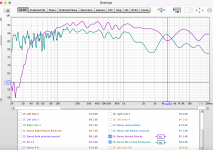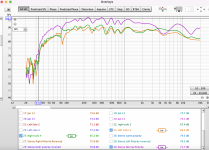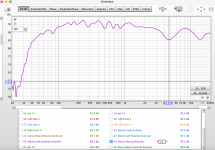I have done so much DSP I am running out of memory on my DCX2496 haha. I got the curve looking pretty decent (the one I posted) then put them up on tripods facing a different wall and it totally changed the frequency response due to the room acoustics. So I was thinking of taking them outside to do my sweeps and DSP what do you think about that? Vs. tuning for a specific room. I have a high pass at 40hz since I will always use these with subs. I definitely listen to modern techno 🙂Good effort. I personally would cut the 1khz to 2khz by 3db, and 150 to 350 by 3db.
Are you sure there isnt a protective high pass filter set on your xover unit? Because it looks like it needs a serious low end boost currently about -4 or -5db at 50hz dropping further to about -20 at 40hz. This would be bad for modern techno or drum and bass. That said if you don't listen to that or anything with deep bass it would probably be fine.
I have done so much DSP I am running out of memory on my DCX2496 haha. I got the curve looking pretty decent (the one I posted) then put them up on tripods facing a different wall and it totally changed the frequency response due to the room acoustics. So I was thinking of taking them outside to do my sweeps and DSP what do you think about that? Vs. tuning for a specific room. I have a high pass at 40hz since I will always use these with subs. I definitely listen to modern techno 🙂
Right that explains the drop off. That's one main problem with the DCX: running out of CPU. But that is just 2 wide-ish parametric EQs it shouldn't add had much. If nothing else just do the 1 to 2 khz one it will sweeten the sound a lot.
Yeah I was wondering about that.. and that means all that processing is really only good as practice... it's of no use for actually speaker correction.I have done so much DSP I am running out of memory on my DCX2496 haha. I got the curve looking pretty decent (the one I posted) then put them up on tripods facing a different wall and it totally changed the frequency response due to the room acoustics.
Yes get outdoors away from buildings and start from scratch. Do not add a high pass in this processing, if these speakers are always used over subs this filter becomes redundant and just needlessly burns processor bandwidth.So I was thinking of taking them outside to do my sweeps and DSP what do you think about that? Vs. tuning for a specific room. I have a high pass at 40hz since I will always use these with subs. I definitely listen to modern techno 🙂
If use with subs there should be a high pass filter on the woofer, actually even if used without subs, just set lower.Yeah I was wondering about that.. and that means all that processing is really only good as practice... it's of no use for actually speaker correction.
Yes get outdoors away from buildings and start from scratch. Do not add a high pass in this processing, if these speakers are always used over subs this filter becomes redundant and just needlessly burns processor bandwidth.
Yes go out in the great wide open to do your testing and keep in mind when you get the response like you like it on axis maybe move the mic 40 degrees to one side and look at it.
Last edited:
Heres the comparison between mic straight on and mic at 40 degrees, interesting things happening, what does this test illustrate?If use with subs there should be a high pass filter on the woofer, actually even if used without subs, just set lower.
Yes go out in the great wide open to do your testing and keep in mind when you get the response like you like it on axis maybe move the mic 40 degrees to one side and look at it.
Attachments
Ok got outside and did left and right solo, then tested in stereo. It caused a pretty wild change in stereo on the highs, is this phase cancellation? How do I correct for this?Yeah I was wondering about that.. and that means all that processing is really only good as practice... it's of no use for actually speaker correction.
Yes get outdoors away from buildings and start from scratch. Do not add a high pass in this processing, if these speakers are always used over subs this filter becomes redundant and just needlessly burns processor bandwidth.
Attachments
Is there an alternative for DSP other than the DCX2496 that has more bandwidth? I took these outside and again ran out of memory. Did not have room to make adjustments on the highs.Right that explains the drop off. That's one main problem with the DCX: running out of CPU. But that is just 2 wide-ish parametric EQs it shouldn't add had much. If nothing else just do the 1 to 2 khz one it will sweeten the sound a lot.
Attachments
Looking at that waveguide, it looks like the 6" would fit onto it, a pair of 6" drivers using that waveguide would do wonders for the off axis response and summation between drivers.
Keep in mind there are some things that can't be fixed with EQ like phase and time delay issues.
You may be actually over processing the the speaker since you mention running out of DSP in the DCX.
For a good upper intermediate level DSP I use the DBX360.
You may be actually over processing the the speaker since you mention running out of DSP in the DCX.
For a good upper intermediate level DSP I use the DBX360.
How many filters are you using on each band and did you remove everything from the indoor sessions first?Is there an alternative for DSP other than the DCX2496 that has more bandwidth? I took these outside and again ran out of memory. Did not have room to make adjustments on the highs.
You should only need to develop tuning for a single speaker and then copy it to the other outputs, the two channels should not need completely different correction.
Here is the waveguide: https://www.parts-express.com/B-C-M...=F&custcol_disableshopping=F&undefined=243.15Looking at that waveguide, it looks like the 6" would fit onto it, a pair of 6" drivers using that waveguide would do wonders for the off axis response and summation between drivers.
I am actually using the auto function for time delay on the DCX2496Keep in mind there are some things that can't be fixed with EQ like phase and time delay issues.
You may be actually over processing the the speaker since you mention running out of DSP in the DCX.
For a good upper intermediate level DSP I use the DBX360.
Hello Soundmind
you made some interesting choices regarding the drivers.
With a 6" mid driver I would prefer as HF an 1" driver, because it will easily handle a 4k crossover and behaves nicer above 10k than your 2" driver with the 4" diaphragm.
Your HF driver is optimized for below 1k crossovers.
But since you have this Mid-High driver already, at least find a different horn, because the ME75 design is very outdated.
It has this old school diffraction slot which causes a lot of problems in the vertical direction above 8k.
The ME75 also looses pattern control down low in the vertical axis like most rectangular horns, which causes problems when trying to cross over below 2k.
The problem with finding a better 2" horn: these have gone out of fashion, so I would try to remove the adapter ring on top of the driver ( there should be screws underneath the sealing foam ) and if you are lucky, the remaining exit is 1.4".
For this exit size there are way more horns on the market available.
A lot of people would recommend the RCF HF950, if you should want to go two-way thereby exploiting the capabilities of the 1095TN.
Regarding the problem with running out of DSP power on the DCX.
If you like the controller, simply buy a second one, use one for left and one for right.
This will give you enough horse power to even experiment with the dynamic filters after a while
you made some interesting choices regarding the drivers.
With a 6" mid driver I would prefer as HF an 1" driver, because it will easily handle a 4k crossover and behaves nicer above 10k than your 2" driver with the 4" diaphragm.
Your HF driver is optimized for below 1k crossovers.
But since you have this Mid-High driver already, at least find a different horn, because the ME75 design is very outdated.
It has this old school diffraction slot which causes a lot of problems in the vertical direction above 8k.
The ME75 also looses pattern control down low in the vertical axis like most rectangular horns, which causes problems when trying to cross over below 2k.
The problem with finding a better 2" horn: these have gone out of fashion, so I would try to remove the adapter ring on top of the driver ( there should be screws underneath the sealing foam ) and if you are lucky, the remaining exit is 1.4".
For this exit size there are way more horns on the market available.
A lot of people would recommend the RCF HF950, if you should want to go two-way thereby exploiting the capabilities of the 1095TN.
Regarding the problem with running out of DSP power on the DCX.
If you like the controller, simply buy a second one, use one for left and one for right.
This will give you enough horse power to even experiment with the dynamic filters after a while
@URI55 Thank you for this comment this is exactly what I was looking for when I posted this on this forum. I have learned a lot about matching the power of drivers since making the post. That is why I went with Tri Amp so I did not have to get it right this time, I could just dial them back as needed. I have learned that the CD is overkill and the mid is underpowered.
I was not aware that 1" CD perform better over 10K than 2" drivers that is very good to know. As for swapping out the horn, this design allows for that fairly easily so I am definitely going to look into this and AB test with the ME75. Thanks again!
I was not aware that 1" CD perform better over 10K than 2" drivers that is very good to know. As for swapping out the horn, this design allows for that fairly easily so I am definitely going to look into this and AB test with the ME75. Thanks again!
- Home
- Live Sound
- PA Systems
- Critique my build! 15" 3 Way PA Loudspeaker


